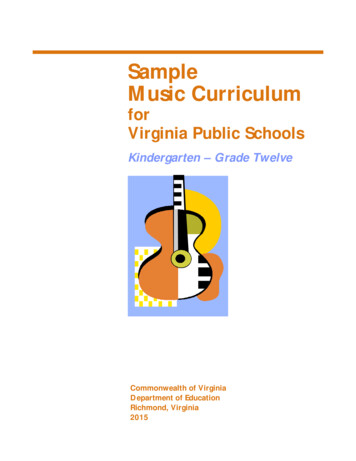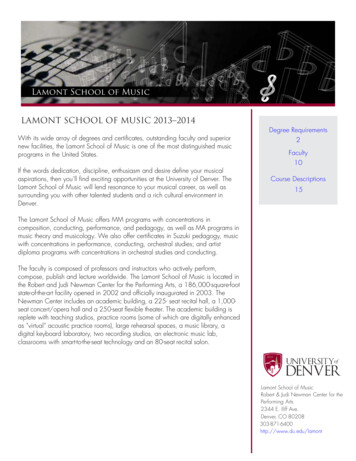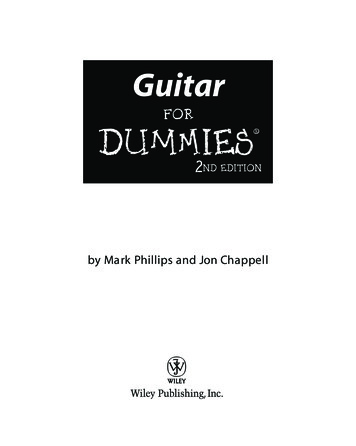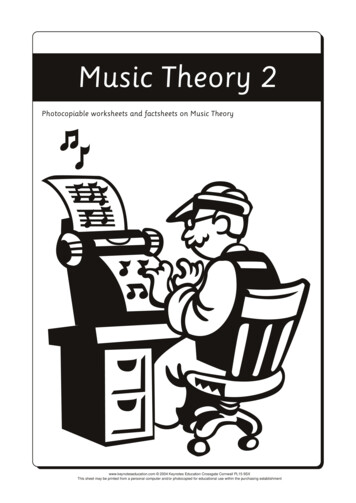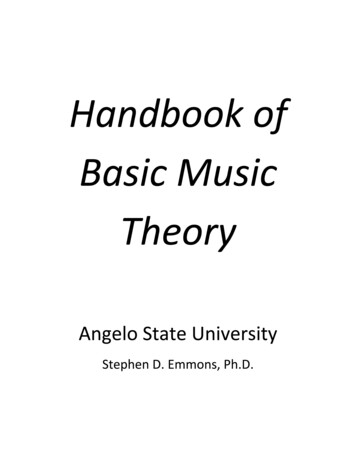
Transcription
Treble Clef - normally used for pitches above C4. Octave registers are shown with brackets.763G54AB C D E F G A BMiddle C or C4Bass Clef - normally used for pitches below C4.21C DEF GABC DEF GAB C43Middle C or C4C DE F GAB CDE F GABC DE F G AB CDE FOctave register designations allow us to name a specific pitch. We say "C4" rather than just "C" when wewant to identify middle C. Shown above are the notes C1 through C7. All the pitches from one particular C upto, but not including the next C, are in the same octave register. Note that ledger lines can be used to extend thestaff above or below. A "pitch class" includes all of the notes with a particular name. For example, "pitch classC" refers to all of the pitches on the piano named C or that are enharmonic with C (such as B ).Please see the sections on major scales and minor scales for a discussion of accidentals and enharmonic notes.Tenor clef - commonly used by bass clef instruments when playing in their highest registersG3A3B3C4D4E4F4G4F4G4A4Middle C or C4Alto clef - used by the violaA3B3C4D4Middle C or C4E4If the bottom note on this keyboard were C4, all note names bracketed (regardlessof accidentals) would be in the same octave register (i.e. G4, B 4 and so forth).
Major ScalesAll major scales have the same pattern of half steps and whole steps that conform to the following example.The half step (semitone) is the smallest interval in tonal music. Any two piano keys that are next to oneanother are a half step apart. This pattern is most commonly a white key to a black key, but the white keynotes E to F and B to C are also half steps. A whole step (whole tone) is simply two half steps.# of half steps:2212221C majorScale Degree Numbers: 123Scale Degree Names in Major Keys:1 Tonic2 Supertonic3 Mediant4 Subdominant5 Dominant6 Submediant7 Leading Tone45671 (the octave)An octave on the pianoIn order to construct major scales on other tonics we need to use accidentals.(sharp) raises a pitch by a half step(flat) lowers a pitch by a half step(natural) cancels an accidental (refers to white keys on piano)(double sharp) raises a pitch by a whole step(double flat) lowers a pitch by a whole step# of half steps:2212221D MajorScale Degree Numbers: 12345671Scales are always named for the tonic note, in this case D .Key signatures are derived from the accidentals required to make a scale on a given note. Key signatures,like scales, are named after the tonic. In other words, the key of D major has D as its tonic. While it isimportant to understand and be able to apply the pattern of half steps and whole steps in creating majorscales, it is also important to memorize all of the key signatures for the major and minor scales.Flats and sharps appear in key signatures in a predictable manner. This order of flats and sharps is asfollows:Order of flats BEADGCFOrder of sharps FCGDAEBFor example, if a key signature has two flats, they will be B and E, and if a key signature has 3 sharps,they will be F, C, and G.
There are three methods of constructing minor scales. The first and most tedious way is to count half stepsand whole steps (semitones and whole tones). This method is useful for demonstrating the exact layout ofa minor scale. However, the likelihood of making mistakes is increased.There are three forms of minor scales: natural minor, harmonic minor, and melodic minor. The natural minorscale features only the accidentals found in that scale's key signature, while both the harmonic and melodicminor scales feature accidentals not found in the key signature. Melodic minor also features a descendingform of the scale in which the scale reverts to natural minor.# of half steps:2122122a natural minorScale Degree Numbers: 12345671The names of the scale degrees are exactly the same as they are for major scales with one exception.In natural minor, scale degree 7 is referred to as the "subtonic." In harmonic and melodic minor the seventhscale degree is a half step below the tonic and is called the "leading tone" as it is in major scales.# of half steps:2122131a harmonicminorscale degree numbers: 1# of half steps:a melodic minor(ascending form)scale degree numbers: 1223124235246257261171
The second way of constructing minor scales is to take the parallel major of that scale and then altercertain scale degrees. Parallel major/minor scales (keys) are scales that have the SAME tonic butDIFFERENT key signatures. For example, if a c minor scale is needed, construct a C major scaleand then alter scale degrees 3, 6, and 7 as needed.Below is a C major scale. If a c natural minor scale is desired, then scale degrees 3, 6, and 7 of theC major scale should be lowered by a half step (semitone).If a c harmonic minor scale is needed, scale degrees 3 and 6 should be lowered by a half step, leavingscale degree 7 untouched.If a melodic minor scale (ascending) is wanted, then only scale degree 3 should be lowered by asingle half step.Remember -- a natural note (white key note on the piano) is raised a half step by using a sharp ( ) andlowered a half step by using a flat ( ). A note that is already modified by a flat is further lowereda half step with a double flat ( ) and raised a half step with a natural ( ). A note that is already modifiedby a sharp ( ) is lowered a half step with a natural ( ) and raised a half step with a double sharp ( ).C majorc natural minor367367c harmonic minorc melodic minor (ascending)367Remember that melodic minor in its descending form is simply the natural minor scale.
The third way of constructing a minor scale utilizes the concept of "relative" major and minor keys.Relative major/minor scales (keys) are scales that have the SAME key signature but DIFFERENT tonics.For example, if you are asked to construct a g natural minor scale, you need merely to find the key signatureof its relative major. Finding relative keys is easy. If you are presented with the minor tonic (in this caseg), you need to go UP three half steps (semitones) or a m3 (see section on intervals) to find the tonic of itsrelative major. If you need to find the relative minor of a given major tonic, then you must go DOWN threehalf steps (semitones) or a m3 from the tonic of the given major. This note is also scale degree 6 of the givenmajor scale. Please see the bottom of this page for a discussion of enharmonic note spellings.g minor tonicB major tonicC major tonica minor tonicB major's key signature includes 2 flats; therefore, the key signature for g minor has the same 2 flats.The same reasoning holds for the key of C major and a minor, both of which have no sharps or flats inthe key signature.B major . . . . . . . . . . . . is the relative major of . . . . . . g minorIf you need to construct an harmonic minor scale, follow the steps above and then raise scale degree 7 by onehalf step (semitone).7g harmonic minorIf you need to construct a melodic minor scale (ascending form), follow the above steps and then raisescale degrees 6 and 7 by one half step (semitone).g melodic minor (ascending)67Enharmonic SpellingsThe third scale degree of a given minor scale is also the tonic of its relative major, and the sixth scale degreeof a given major scale is also the tonic of its relative minor. It is important to go up 3 letter names whencounting the half steps in order to avoid spelling a key enharmonically (in this example C the 1st lettername, D the 2nd letter name, and E the 3rd letter name). Enharmonic notes sound the same and sharethe same piano key but have different spellings. For example, E and D share the same pitch and the samepiano key but not the same spelling. E major (NOT D major) is the relative major of c minor. Becauserelative keys have the same key signatures, they will either both have sharps or both have flats.C minor . . . . . . . . . is the relative minor of . . . . . . . . . . Eb major3 tonic of its relative major6 tonic of itsrelative minor
C/a (0)F/d (1b)G/e (1#)Bb/g (2b)D/b (2#)Eb/c (3b)A/f# (3#)Ab/f (4b)E/c# (4#)Db/bb (5b)C#/a# (7#)Cb/ab (7b)B/g# (5#)Gb/eb (6b)F#/d# (6#)This is the circle of fifths. By reading this chart clockwise, you will notice that the tonic of each new keyis a P5 (see section on intervals) above the tonic of the previous key. In other words, each key starts on thedominant scale degree of the previous key. G is the fifth scale degree (dominant) in C major. G is also thenext key on the circle of fifths.By reading this chart counter-clockwise, you will notice that the tonic of each new key is a P5 below thetonic of the previous key. In other words, each key starts on the subdominant scale degree of the previouskey. F is the fourth scale degree (subdominant) in C major. F is also the next key on the circle of fifths.Notice also the enharmonic keys at the bottom of this chart. The Circle of Fifths should be memorized.
Key SignaturesBelow are the major and minor key signatures written in the four most commonly used clefs.Note that relative major/minor keys have the same key signature.C major/a minorB major/g# minorEb major/c minorG major/e minorF# major/d# minorAb major/f minorA major/f# minorD major/b minorC# major/a# minorDb major/bb minorF major/d minorGb major/eb minorE major/c# minorBb major/ g minorCb major/ab minor
An interval is the distance between two notes. Intervals can either be harmonic (played at the same time)or melodic (played successively).Intervals are identified by a number and a modifier. The half step (semitone) is the smallest interval in tonalmusic. Any two piano keys that are next to one another are a half step apart. This pattern is most commonlya white key to a black key, but the white key notes E to F and B to C are also half steps.Interval modifiers include perfect (P), major (M), minor (m), augmented ( ), and diminished (º).Intervals that can be perfect 1, 4, 5, and 8. (1 unison and 8 octave)Intervals that can be major 2, 3, 6, and 7.Intervals that can be minor 2, 3, 6, and 7.Any interval can be augmented, and any interval can be diminished.Identification of Intervals1) Count the interval's numerical name. Start on the bottom note and call it "1" and continue to the top note.Do not skip a note name. In the following example, C 1, D 2, E 3, F 4, G 5, and A 6. The numericalname for this interval is a 6th.M62) Think of the key of the bottom note. Is the note "A" the normal sixth scale degree in C major?Yes it is, which makes this a M6.It is important to memorize the intervals contained in the major scale.M2M3Scale Degrees1-2M2P41-3M31-4P4P51-5P51-6M6M61-7M7M7P81-8 (1)P8Perfect intervals made larger by a half step (semitone) become augmented (i.e. P5 becomes an 5)Perfect intervals made smaller by a half step (semitone) become diminished (i.e. P5 becomes a º5)Major intervals made larger by a half step (semitone) become augmented (i.e. M3 becomes an 3)Major intervals made smaller by a half step (semitone) become minor (i.e. M3 becomes a m3)Minor intervals made smaller by a half step (semitone) become diminished (i.e. m3 becomes a º3)Minor intervals made larger by a half step (semitone) become major (i.e. m2 becomes a M2)
This is a list of commonly encountered intervals. This list is NOT exhaustive.Interval nameP1m2M2 2m3M3P4 4º5P5m6M6 6m7M7P8 # of half steps (semitones)0 (unison)1233456 (tritone)6 (tritone)78910101112 (octave)Just as there are enharmonic spellings for notes, there are enharmonic intervals as well.The 6 sounds the same as a m7 but is spelled differently. An 6 above C is an A#, while a m7 above Cis a Bb. A# and Bb are enharmonic and are both 10 half steps (semitones) above C, but one is countedas a sixth and the other as a seventh.Doubly diminished and doubly augmented intervals are possible but are not commonly encountered. We willnot consider them during this course.
How to write an interval ABOVE a given note.Example: Write a m6 above the given note.1) Find the note a sixth above E, using E as 1. The note a sixth above E is a C.2) Think in the key of the bottom note (E major). C# is the sixth scale degree in the key of E major. C# istherefore a M6 above C. C is a m6 above C.Sometimes you will be asked to write an interval above a note that is the tonic of an unusual key, such as F .You should temporarily remove the accidental and then add it back when you have determined the interval.Example: Write a P5 above F .P5P51) Remove the flat so that you are now thinking in the key of F. A P5 above F is C. When you add the flatback to the F, you must also add a flat to the C to maintain the P5.
This is how to write an interval BELOW a given note.A good way to write an interval below a given note is to first invert the interval and find this inversion abovethe given note. After this note is found, you will then place it an octave lower thus putting the notebelow the given pitch.Inversion of an interval happens when the bottom pitch is placed above the top pitch (or the top pitch isplaced below the bottom pitch). To find the inversion of an interval, subtract the number of the intervalfrom 9. The number 9 is a constant value -- the sum of an interval and its inversion will always add up to 9.The following should be memorized:7ths invert to 2nds (and vice versa)6ths invert to 3rds (and vice versa)5ths invert to 4ths (and vice versa)major intervals become minorminor intervals become majorperfect intervals remain perfectdiminished intervals become augmentedaugmented intervals become diminishedExample: find the inversion of a m69-6 3, so the inversion of a m6 is some kind of 3rd. Furthermore, minor intervals invert to major intervals,so a m6 inverts to a M3.Example: Write a P4 below the given note:Step #1 -- a P4 inverts to a P5Step #2 -- write a P5 above the given noteStep #3 -- drop the note an octave to place it below the given note -- this is the answer.
This "rhythm tree" shows values from the whole note through the sixteenth note.Whole NoteHalf NoteQuarter NoteEighth NoteSixteenth NoteA tie connects two notes that are the same pitch. Add the tied notes together to get the new duration. For example,A dot makes a note longer. You add one-half of the original note's value when you add a dot to it.For example, A note that is double dotted adds one-half of the original note's value and one-half the valueof the first dot. For example,
The beat is the pulse of the music. It is what we clap to, dance to, and march to. Tempo describes how fastthe beats occur. It is described through the use of words (often Italian) and by the use of metronome markings.Metronome markings show how many beats occur in a minute. For example,means that there are60 quarter notes occuring every minute, or one a second. Some beats are accented, which means they arestronger than other beats. Note that the first beats (downbeats) are all strong.MeterDuple meters (strong - weak) contain 2 beats.Triple meters (strong - weak - weak) contain 3 beats.Quadruple meters (strong - weak - somewhat strong - weak) contain 4 beats.Division of the beatBeats that divide into 2 equal parts are called simple beats. Simple beat notes are not dotted.Beats that divide into 3 equal parts are called compound beats. Compound beat notes are dotted.Both simple and compound meters can be duple (2 beats a measure), triple (3 beats a measure), or quadruple(4 beats a measure).Time Signatures (meter signatures) show how many beats are in a measure and which note value gets a beat.Time signatures for simple beats have 2, 3, or 4 at the top. The top number shows the number of beats in ameasure, while the bottom number shows the beat note value. Simple meters with 2 at the top are duple, thosewith 3 as the top number are triple, and those with 4 are quadruple.If the bottom number in a time signature is 4, the quarter note is the beat note. If the bottom number in a timesignature is 8, the eighth note is the beat note. If the bottom number is 2, then the half note is the beat note.Some common simple meters are:2 3 4 2 3 4238 8 8 4 4 42242444 beats per measure, with each beat dividing into 2 eighth notes323 beats per measure, with each beat dividing into 2 quarter notes383 beats per measure, with each beat dividing into 2 sixteenth notes
Time signatures for compound beats have 6, 9, or 12 at the top. The top number shows the number ofdivisions in a measure, while the bottom number shows the division value. Dividing the top number by 3will yield the number of beats in the measure. For example, 6 3 2, which means that meters with 6 asthe top number are duple meters; 9 3 3, which means that meters with 9 as the top number are triplemeters; 12 3 4, which means that meters with 12 as the top number are quadruple meters.A compound time signature with a bottom number of 8 means that the division is an eighth note and thatthe beat is a dotted quarter. A compound time signature with a bottom number of 16 means that the divisionis a sixteenth note and that the beat is a dotted eighth. A compound time signature with 4 at the bottommeans that the division is a quarter and that the beat is a dotted half.Some common compound meters are:6 9 12 6 9 12 6 9 1216 16 16 8 8 8 4 4 4682 beats per measure, with each beat dividing into 3 eighth notes9163 beats per measure, with each beat dividing into 3 sixteeth notes1244 beats per measure, with each beat dividing into 3 quarter notes
There are four types of triads. Each has a different structureMajorMinorM3M3m3P5P5DiminishedAugmentedm3 5º5m3M3M3m3There are five types of commonly used seventh chords.Major-MajorMajor-MinorM3M7m3P5M3m7 P5Minor-Minorm3m3M3Half Diminishedm3m7 P5Diminishedm3M3m3M3 m7º7 º5m3º5m3m3m3The structures of these triads and seventh chords should be memorized!These nine chord types are among the most common sonorities in Western music.There are only 7 possible spellings (not including accidentals) for triads and seventh chords. These patternsshould also be memorized.Triads CEG DFA EGB FAC GBD ACE BDFSeventh chords CEGB DFAC EGBD FACE GBDFACEGBDFA
After the structures of these various chords are memorized, writing them becomes easy. Use your intervalwriting skills to your advantage.Example: write a minor chord on the following rootStep #1 -- Fill in the needed notes above the given note. The root of this chord is E , so the chord MUSTbe spelled using a G and a B.Step #2 -- What type of 3rd is G above E ? It is a major third, so it must be lowered by one half step(semitone) to become a m3.Step #3 -- You can either find out what type of 3rd B is above G , or you can find out what type of 5th B isabove E . Either way you must make whatever modifications are necessary to complete the chord.Example: write a Mm7 chord using the given note as the 5thStep #1 -- Fill in the root, 3rd, and 7th.Step #2 -- Because the B (the 5th of the chord) is given, it cannot be changed. The top interval of a Mm7 isa m3. Find the m3 above B .Step #3 -- Find the m3 below B .Step #4 -- You can either find the M3 below the G or a P5 beneath the B . Either will yield the correctanswer.
Below are lead-sheet symbols for the four triad types and five seventh chord types covered in MUS 1350.Please note that this system is not completely standardized in textbooks and published music; thereare often several symbols that can be used to represent a given chord.Lead sheet symbols:CCmCdim or CºC Chord type: majorminordiminishedaugmentedLead sheet symbols:CMaj7 or CM7Chord type: eventhCØ7halfdiminishedseventhCdim7 or Cº7diminisheddiminishedseventhLead-sheet symbols can be used to harmonize a melody. The usual custom is to place the lead-sheet symboldirectly above the measures in a melody.
Chords can appear in root position or in inversion. There are three bass positions for triads and four basspositions for seventh chords. Root position chords feature the root as the lowest note (in the bass). Firstinversion features the 3rd of the chord as the lowest note (in the bass). Second inversion features the 5thof the chord as the lowest note (in the bass). Seventh chords allow the possibility of third inversion, inwhich the seventh of the chord is the lowest note (in the bass).These inversions are indicated through the use of bass position symbols. During the Baroque period, Arabicnumerals were added to bass lines to show the accompanying harmonies. This system of figured bass symbolsis now used in tonal music theory in a simplified form. These numbers indicate intervals above the lowest notein the texture, even if it is in treble clef. For the purposes of this class, we will normally assume these are"simple" intervals, intervals that are smaller than an octave. In part-writing and analysis, however, thesenumerals often refer to "compound" intervals, intervals that are larger than an octave.Root pos.Complete 5Symbol 3MostCommonSymbol1st inv.2nd inv.Root pos.1st inv.2nd inv.3rd inv.63647536536436426647654342These bass position symbols should be memorized.In addition, various symbols may be combined with these bass position symbols to raise or lower a pitch.For example, a or next to a numeral or slash through a numeral indicates that you should raise that noteby a half step (semitone). A symbol next to a number indicates that you should lower that note by a half step.Key of C major6 43If there are no modifying symbols next to a bass position symbol, you should use the notes found in the diatonicscale (i.e., use the accidentals found within the key signature). This next example is in C major, a key with 7sharps in the signature. Notice how there are NO indications to raise or lower a note in the bass position symbol!7 42The important point to remember regarding bass position symbols is to take them literally. For example, a firstinversion triad has notes a sixth and a third above the bass, a second inversion triad has notes a sixth and fourthabove the bass, and so on.
The key of C major has no sharps or flats. The seven white key notes found within the key of C majorare said to be diatonic in that key, while any notes that are sharp or flat are called chromatic. We will dealonly with chords that are diatonic within a given key. Diatonic chords only use accidentals found withinthe key signature. F is a diatonic note in G major, and a D F A chord is therefore a diatonic chord withinG major. The note C , whether used as part of a chord or as a non-chord tone, would be chromatic.There are 7 diatonic triads and 7 diatonic seventh chords in any given major key. In tonal theory, Romannumerals are often used to identify the chord type (major, minor, etc), and the root of a chord.Diatonic chords in major (example is in C major)Scaledegree1234567Chord umeralIiiiiiIVVviviiº567Diatonic seventh chords in major (example is in C major)ScaledegreeChord ishedseventhviiØ7Capital Roman numeral major triad (I)Lower case Roman numeral minor triad (ii)Capital Roman numeral with " " augmented triad (III )Lower case Roman numeral with "º" diminished triad (viiº)Capital Roman numeral with "M7" major major seventh chord (IVM7)Capital Roman numeral with "7" major minor seventh chord (V7)Lower case Roman numeral with "7" minor minor seventh chord (vi7)Lower case Roman numeral with "Ø7" half diminished seventh chord (viiØ7)Lower case Roman numeral with "º7" diminished diminished seventh chord (fully diminished seventh chord)(viio7)
Because of the existence of harmonic and melodic minor scales, the situation in minor is more complicated.There are 13 possible diatonic triads and 16 possible diatonic seventh chords in a given minor key.Diatonic triads in minor (example is inthe key of a minor)***Asterisk (*) indicates most commonly used chords usedin minor keys****Scale 1degree223344556677Chord mtypeRoman inumeraldimmMaugmMmMMdimMdimii iiIIIIII ivIVvVVIvi VIIvii Diatonic seventh chords in minor (example isin the key ofa minor).Scale degree lfdiminished majorseventhseventhiiØ7IIIM7Shown are the 7 most common seventh chordsused in minor majorseventhV7VIM77diminisheddiminishedseventhvii 7In minor keys, all of the common triads and seventh chords are constructed using the natural minor formof the scale EXCEPT for the V, V7, vii and vii 7. These utilize the leading tone, which is the raisedseventh scale degree found in harmonic and melodic minor scales. Indeed, the purpose of the harmonicminor scale is to enable the creation of the V and viiº chords in minor. MAKE SURE YOU REMEMBERTO ADD THE LEADING TONE TO THESE CHORDS IN MINOR. The leading tone of a root positionV chord will be the third of the chord. The leading tone of a root position seventh chord will be the rootof the chord
This is the circle of fifths. By reading this chart clockwise, you will notice that the tonic of each new key is a P5 (see section on intervals) above the tonic of the previous key. In other words, each key starts on the dominant scale degree of the previous key. G is th




